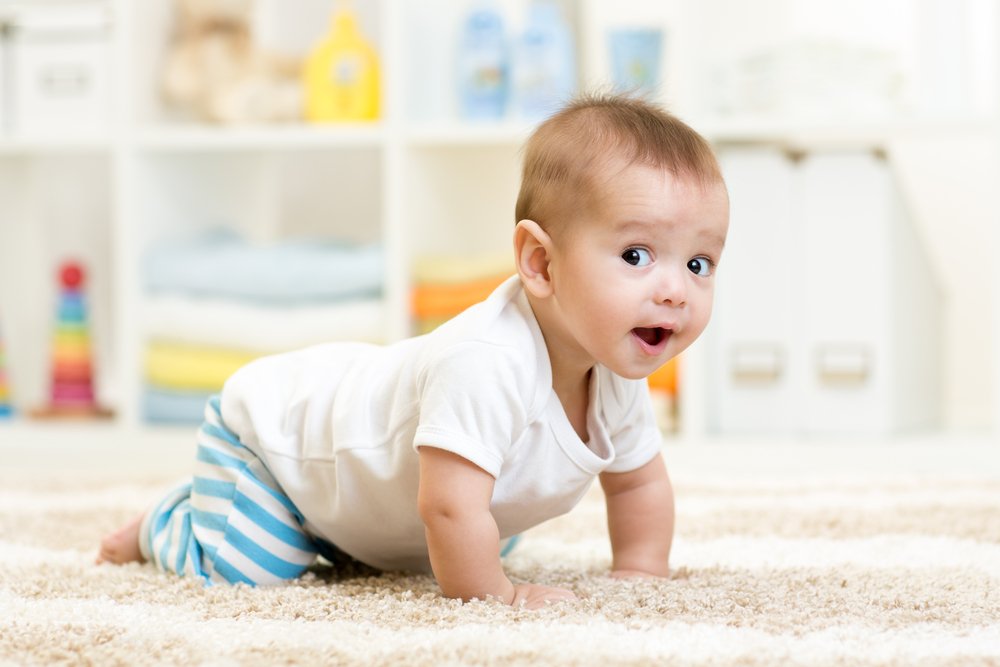Key points:
- Babies may crawl backward before they crawl forward during their learning process.
- Crawling develops between 6 to 10 months, and not all babies crawl in the same way.
- Tummy time is crucial to prepare your baby for crawling by strengthening their upper body muscles.
- Support your baby’s crawling development through reaching exercises and tummy time activities.
During their learning process, you might see your baby crawling backwards before getting the hang of it and moving forward. Learn why.
Watching your baby crawling and moving on their own can be truly memorable moments. Try to take advantage of this brief period, because before you know it, your little one will start to pull up, stand and walk!
As we’ve previously discussed, crawling can occur between the 6- to 10-month mark, and not every baby crawls in the traditional manner. We’ve talked about the different styles of crawling and how your little one can adopt other kinds of movements to get around, like rolling or shuffling.
During this learning process, you might see your baby crawling backwards before getting the hang of how to crawl forward. But why does this happen?
Why is your baby crawling backwards?
When babies are starting to crawl, it’s very common to see them crawling backwards. As they explore the world, they use their arms and upper body as a first approach when playing or exploring something. During tummy time, babies use their arms to lift themselves up and support their neck; this is why spending time in this position is very important to get your baby ready to crawl.
By laying on their tummy, babies develop the strength needed to get into a crawling position, and their upper body muscles will develop faster than the lower ones. That’s why, as they explore, they might find it easier to push themselves backwards instead of pulling themselves upwards and moving forward, when they attempt to move.
Since your baby’s arms are more developed than their legs, you might notice they push themselves back further away from the toy they want to reach. Because all the strength is primarily focused on the upper part of their body, your baby might need your help to understand the mechanics of crawling and how to start pushing their body forward with their legs.
How to help your baby crawl
Here are some ideas that you can do to help your baby to crawl:
- Encourage reaching by putting your baby’s favorite toy, object, or even yourself in front of them and out of reach, and help your baby move to reach the object.
- When you see your baby is ready to make a move, place your hand behind their feet to act as resistance and help your baby push forward.
- If your baby is struggling to crawl, support their hips to make them feel comfortable to move forward. Reduce your support as your baby gets stronger in the crawling position.
- Tummy time provides a solid foundation for crawling. Practice tummy time exercises and show your baby how to use their legs to support the body and strengthen the lower muscles, as well as the neck, head, and back. You can try to practice tummy time in different locations, such as indoors on a mat, or outdoors on a blanket. Also, singing and talking while you do it may help!
- Playing on the floor together can be a great way to incorporate movement to your games. Playing is not only fun for your baby, but it is also a great opportunity for your little one to learn a lot. Some simple things like moving objects from side to side in front of them, or turning the pages of a book will help build your baby’s physical skills.
- Give your baby time and safe areas to practice movement, and provide them with as many chances to move as you can. This can also be done by limiting the time that your baby spends in strollers, cribs, baby seats, walkers and other devices that restrict movement.
- Placing large pillows on the floor and putting toys on top can encourage your baby to crawl up to them. It will be easier for your baby to go forward once they get on their knees and up onto the pillows.
- Make sure to babyproof your house so that your baby has a safe space to move around and explore. If you can, move any obstacles (like furniture), place gates on staircases, and block off rooms that you’d rather your baby didn’t explore, so they can crawl around without the risk of getting injured.
- Always supervise and stay close to help your baby play safely. Playing face to face during tummy time is a great way to see if your baby is getting tired or not enjoying the activity.
As you practice and strengthen your baby’s muscles, try playing catch and see if your little one crawls away or chases after you. With time and practice they’ll discover that, by digging with their knees and pushing off the ground, they can propel themselves towards the target of their choice. The important thing is that your baby is able to explore their surroundings and strengthen their body in preparation for walking.
Some babies are better at crawling than others, so don’t worry if your baby is crawling backwards or if they figured out a different way of getting around. As long as they are learning to coordinate both sides of their body using their arms and legs, there’s no reason to be concerned.
Although there are guidelines and generalities regarding developmental milestones like crawling, babies develop differently and each at their own pace. So don’t be alarmed if the development of your baby takes a slightly different course. However, if you feel your child is not moving normally, or you’re concerned about any areas of your baby’s development, you can always contact your pediatrician.








